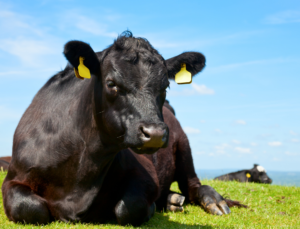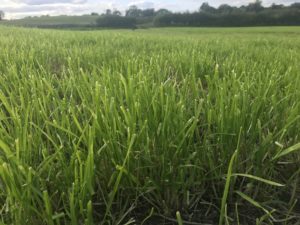Spring growth was delayed by roughly a month, with prolonged dry cold frosty weather causing havoc with grass growth. However, the rainfall during May followed by higher temperatures of June brought some much-needed heat during the day and ideal growing conditions, grass crops played catchup and grew rapidly in about 10-14 days.
Well managed grass can improve stock performance and farm efficiency. Starting with an early turnout in the spring has many benefits including reduced labour hours, more contented stock and cheaper liveweight gain. Economically, more expensive feeds can be displaced by grass and an early turnout of stock will increase the quality of grass in subsequent rotations.
When to graze?
In an ideal world, grass is grazed early to allow re-growth for the following ro tation, and of course, you must ensure grass does not run out before your next rotation begins. Perennial ryegrass only ever has three live leaves on every individual plant (tiller) at any time; once the fourth leaf starts to grow, the first and oldest leaf dies. Grazing swards at the 3 leaf stage is key to prevent plants from getting to the fourth-leaf stage and dying, this reduces wastage and the build-up of unproductive dead leaves at the base of the sward. Remember, grazing grasses too early, before the second new leaf appears, can damage grass persistency. If a plant’s reserves have not been fully restored, future growth will be in jeopardy. It is easier to cut and round bale excess grass than it is to start buffer feeding when swards become depleted so always err on the side of caution when choosing fields for grazing and allow a little more than you think will be required.
tation, and of course, you must ensure grass does not run out before your next rotation begins. Perennial ryegrass only ever has three live leaves on every individual plant (tiller) at any time; once the fourth leaf starts to grow, the first and oldest leaf dies. Grazing swards at the 3 leaf stage is key to prevent plants from getting to the fourth-leaf stage and dying, this reduces wastage and the build-up of unproductive dead leaves at the base of the sward. Remember, grazing grasses too early, before the second new leaf appears, can damage grass persistency. If a plant’s reserves have not been fully restored, future growth will be in jeopardy. It is easier to cut and round bale excess grass than it is to start buffer feeding when swards become depleted so always err on the side of caution when choosing fields for grazing and allow a little more than you think will be required.
When in a grazing cycle, the two main obstacles faced when managing swards are soil conditions and rainfall. Be careful with heavy land, especially after periods of rain as poaching of swards can reduce growth rates by as much as 20%. Visual checks of your fields will soon bring any issues to your attention and simple things like on/off grazing or temporarily moving stock to drier land will help alleviate any ground condition issues.
Grazing swards in prolonged dry spells of weather can be equally testing, both in terms of production and patience! It is important to maintain grass covers by reducing demand by using a supplement forage or concentrate. The dry matter content of swards will likely have increased significantly so paddocks should in theory last longer. Give some consideration to strip grazing paddocks rather than block grazing during a dry period, as anything not grazed down to 4cm is wasted forage. Ensuring swards are not overgrazed is vital during a dry time and leaving a longer residual will help the grass recover quicker for the next rotation.
White clover is important for grazing swards, fixing up to 150kg/ha per year of atmospheric nitrogen, it reduces the need for bagged nitrogen and improves soil structure and stock performance. It can also help with the seasonal dip in grass growth in the summer. Multi species swards with herbs, legumes and grasses respond well to rotational grazing. They offer benefits for soil structure from deeper rooting species, animal performance and animal health due to their higher mineral and protein content. As well as maintaining production during dry spells as they are better able to cope.
Multi species herbal leys are becoming more common as the transition to ELMS (Environmental Land Management Scheme) progresses.
Monitor your swards pre and post grazing
Before livestock start to graze, carry out a visual assessment and look for any issues that may affect production later in the year. Early action on broad-leaved weeds prevents an unmanageable infestation later in the year. Ask yourself; Is your sward dense enough to carry animals when grazing without poaching? Is your grass a healthy green colour or is it starting to show signs of stress or nutrient deficiency? Patchy areas in your sward can indicate compaction and poor soil structure. Visual checks after grazing could perhaps identify grasses that haven’t been eaten off as well as others. Perhaps the seed mixture used in this field isn’t ticking all the boxes or perhaps annual meadow grass and other weed grasses are starting to take over. Making all of these observations will help you identify which swards need over-seeding or re-seeding. In an ideal world, at least 15% of your grazing fields should be re-seeded every year but we know that isn’t always possible. Re-seed where you can and if other swards need a boost for a couple of years then over-seed with varieties that have been tested based on density, palatability and yield.
For further advice on maximising your yields from grass, speak to your local NWF Sales Specialist or read and order NWF grass seeds Online.

